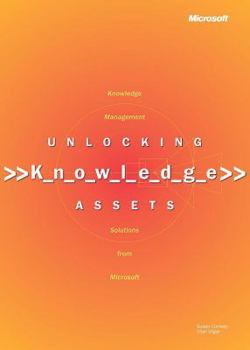Unlocking Knowledge Assets
The intangible asset that resides in the mind of the employee-shared knowledge about work processes, roles, corporate culture, products, and services-is the lifeblood of any knowledge-based... This description may be from another edition of this product.
Format:Paperback
Language:English
ISBN:0735614636
ISBN13:9780735614635
Release Date:March 2002
Publisher:Microsoft Press
Length:1 Pages
Weight:1.30 lbs.
Dimensions:1.0" x 7.0" x 9.1"
Customer Reviews
3 ratings
The Microsoft Solution for Communities of Practice
Published by Thriftbooks.com User , 21 years ago
Conway & Sligar take the idea of a community of practice one step further than Wenger, McDermott and Snyder (In the book "Cultivating communities of Practice"). The central theme is knowledge management, with the problem being how to transfer knowledge from one generation of workers to the next. Conway & Sligar argue that employee loyalty is not common anymore and in fact employee's transfer jobs today more than in the past. The authors write that one way to enable knowledge management is to establish and promote communities. A community of practice is a group of people who share things like information, ideas and personal experience in an area of expertise. The authors see a CoP operating at the workgroup, department or corporate level. An example of a CoP is the Microsoft Database Management community which is focused on the use of Sql server and whose members are scattered around the world. In this community of practice the users of the knowledge give feedback to the producers of the knowledge through a rating system.Conway & Sligar view knowledge management as a cycle with a number of stages of which a community of practice is one. A person or individual usually creates knowledge. Then the knowledge is shared where a community or group explore the knowledge in greater detail, discuss, argue and analyze. Then the knowledge may undergo refinement in a collaborative corporate environment. Finally the knowledge may enter the public space for mass adoption. In the knowledge management scenario of Conway & Sligar the CoP plays a major role in the second stage. The CoP can be formal or informal and the members share a common sense of purpose. It can be internal or external to the company and be based on a product, technology, role, function, industry or market. The authors believe that a community profile document should be created with items such as: a vision statement, a mission statement, roles & responsibilities and objectives for the community. In a CoP a number of community roles need to be filled such as: a community leader, subject matter expert, special interest group leader, the expert, community member, guest and launch team. The authors believe that the community must be compelling and fully engage members, where all members are fully rewarded for their contributions.The authors both work for Microsoft Consulting Services in the area of knowledge management. They base their ideas of communities of practice firmly around the Microsoft Sharepoint collaboration software solution (which runs as an Active Server Pages application in Windows 2000 Internet Information Server). This software includes threaded discussion forums as part of its functionality for knowledge management. In fact communities of practice should be implemented with the discussion board functionality of the software. Discussion board software forms the core feature of many web sites using virtual community. Therefore, the authors end up blurring the boundaries be
A KM Breakthrough
Published by Thriftbooks.com User , 22 years ago
Unlocking Knowledge Assets is not only a great overview of the much-misunderstood KM field; it is truly a breakthrough management science. With great brevity and clarity the authors outline how knowledge management's effectiveness can be accurately measured and linked to the goals of your business. If managers can pinpoint what knowledge worker activities are producing results, then those activities can be encouraged and rewarded. Taking the maxim "you can't manage what you can't measure" to heart, this book provides a first-of-its-kind paradigm that should shed new light on a firm's most valuable and mysterious resource: knowledge.David H. Brett, CEO and Founder, Knexa.com
Excellent for the business executive
Published by Thriftbooks.com User , 22 years ago
This book is written for the business executive to help them make the decision to implement a KM system in their organization. Even though the book is written by Microsoft Consultants it is not a sales pitch for Microsft technologies. The expertise these authors bring to this topic makes the book an excellent read for anyone planning to implement KM. They begin by discuss the importance of making sure the culture is represented within the system in order to support adoption and constant growth of the knowledge assets contained in the system.





